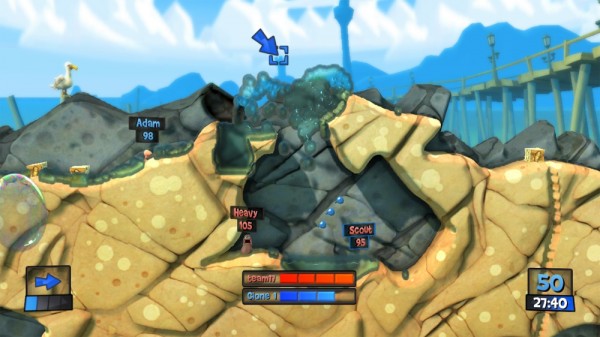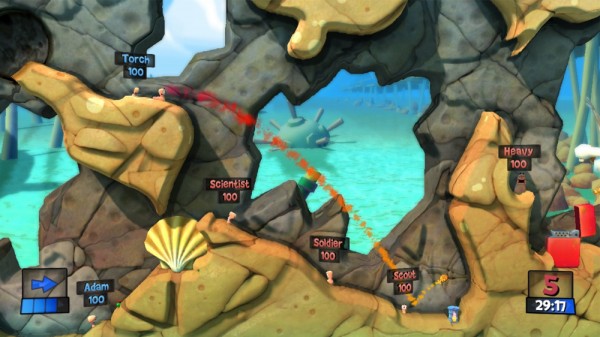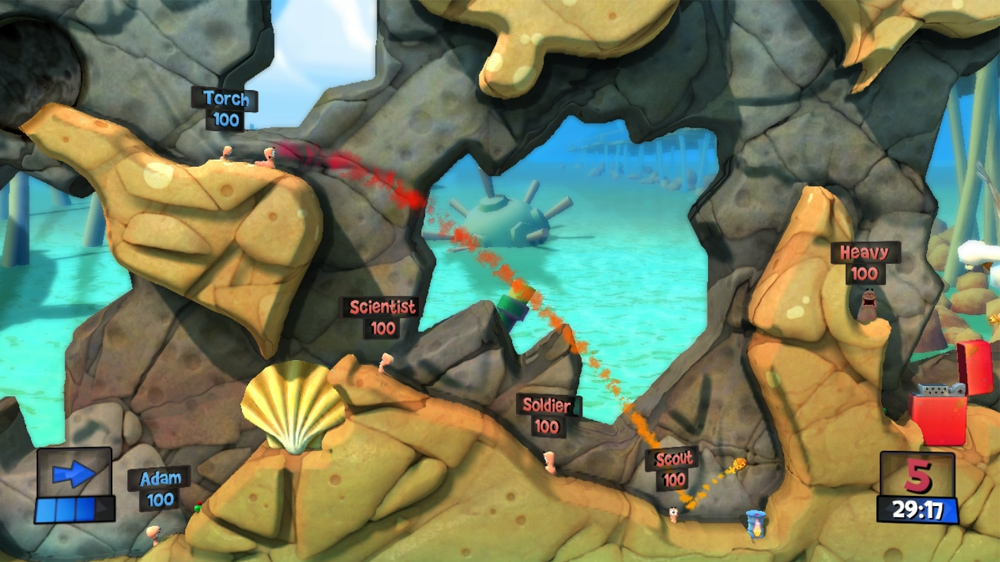
At first glance, you could be forgiven for assuming Worms Revolution is little more than a merging of the two paths the franchise has taken over the years. The game plays out on a 2D plane, like the original few games, presented in the snazzier 3D graphics of the mid-naughties Worms. But digging around in the dirt playing with the Worms this week, I found a few nuggets that might make you think otherwise.
We’d heard about features like worm classes, dynamic water and “physics objects”, but their importance was hard to determine without hands-on experience.
If you’re a Worms veteran, you no doubt have a few go-to strategies in your playbook. Revolution accommodates a lot of classic techniques, actively encourages some (an entire tutorial mission is dedicated to the “Darksider” playstyle) and throws more than a few spanners in the works.
Perhaps the most game-changing spanner (at least in theory, but we’ll get to that) is the inclusion of worm classes. Your standard worm is the Soldier: with average power, resistance, movement speed, etc, this is the kind of worm you’re used to.

The Heavy is a chunkier fellow, less mobile but stronger. His weight means jetpacks and ninja ropes aren’t much use to him, jumping up a slight rise is a challenge, and your turn will be over before he crawls very far. It’s best to bunker him down in the middle of the action, and deal his increased damage to any enemies he can get his pudgy, disembodied hands on.
Invert those strengths and weaknesses, and you have the Scout. He can zip around the landscape with ease, jumping higher and further, but his light weight makes him far more susceptible to being thrown into the sea by enemy attacks. It’s best to have him dart around and shop for crates.
The Scientist is a support class, with slower movement and weaker attacks. He’s more proficient with technical weapons – an air strike or a sentry gun used by a Scientist will deal more damage, apparently. He also heals the entire team each turn that he’s alive, so tunneling him away from the fray is probably best.
Players can build their teams out of any combination of these classes. All the same, one of each, two and two, whatever you like, and you can switch between Formations prior to each match. If you’re scared of change, you could use only Soldiers, but to do so kinda misses the point.
They sound good on paper, but the class differences seem to be fairly minor in practice, unfortunately. More time with the game may reveal greater nuance, but for now it seems players could compile any combination and have the match play out much the same.

Dynamic water may seem less important to those who don’t take pleasure in pretty graphics, but the wide variety of advantages and hazards it creates on the battlefield make it the primary influence on the strategies you’ll need to adopt and adapt.
You might find water pooled around the landscape, dispensed from a variety of weapons, or contained in physics objects dotted around, waiting to be broken open. It will, as expected, dynamically obey the laws of physics, and rush towards the bottom of screen as directly as it can – taking any helpless, unlucky worms along with it. It’s best used as a kind of long-range Prod: squirting enemies with a Water Pistol, or blasting open a natural dam above them, are effective ways to wash them into the sea for an instant kill. Or, if the sea isn’t reachable, water may pool in a valley, with any submerged worms gradually losing health.
Knowing when, where and how to take advantage of water requires a new level of strategy we haven’t yet seen in Worms. How this can be implemented alongside classic strategies is an exciting prospect: maybe pouring water down a Darksider worm’s tunnel would be an effective way to flush them out?
Visually, the game is charming as ever. The characters’ idle and attack animations are more detailed and varied, and give off a great sense of personality.

A perfect addition to the Worms franchise’s long-constructed character is the fantastic casting decision of Matt Berry as narrator/nature documenter, Don Keystone. You may recognize the voice as that of The IT Crowd’s sleazy boss Douglas Reynholm, or the co-creator/star of the bizarre series, Berry & Fulcher’s Snuff Box.
Berry’s confident quips will guide players through the tutorial and campaign, lending a perfect air of unearned authority to his lines. While the quality of the writing may be a bit patchy, Berry’s delivery often saves it. Perhaps it would be best to lose the subtitles though – they can diminish the comedic timing.
Revolution retains the much-loved Worms hallmarks – deep strategic play, comprehensive single player, endlessly replayable multiplayer, excessive customization, quirky humour – wraps it all up in a nice package, and has it delivered by Matt Berry.
With additions and tweaks in all the right places, Worms Revolution feels familiar, but fresh. Keep an eye out for our review of the game when it launches on October 10.


